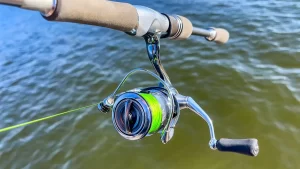For those looking to take spin fishing to the next level, understanding advanced gear options can make all the difference in terms of performance and results. With advancements in technology and engineering, modern spin fishing gear offers a wide range of options that cater to specific fishing conditions and target species. Here’s what you need to know to elevate your spin fishing experience.
Reels: Smoothness and Durability Matter
The reel is the heart of any spin fishing setup, and when upgrading, two key factors to focus on are smoothness and durability. High-end reels, especially those from brands like Shimano, Daiwa, and Penn, offer precision-engineered ball bearings, making reeling incredibly smooth. More bearings generally equate to smoother performance. Reels should also feature durable materials like stainless steel or aluminum for longevity.
Advanced reels also come with fine-tuned drag systems, crucial when fighting large or strong fish. Look for sealed drag systems that keep water and debris out, ensuring the reel performs optimally in both freshwater and saltwater conditions. Another important feature is the gear ratio—higher ratios (6.0:1 or greater) help retrieve line quickly, which is ideal for fast-moving fish, while lower ratios (4.7:1) offer more torque for pulling in larger, harder-fighting fish.
Rod Selection: Power and Action
When upgrading your spin fishing gear, focus on selecting the right rod that complements your reel. The rod’s power, which refers to its strength, is important when targeting specific species. Light rods are ideal for small fish like panfish or trout, while medium to heavy rods work better for bass, walleye, or larger fish like pike.
Action, or the rod’s flexibility, also plays a crucial role. Fast action rods are sensitive to light bites and set hooks quickly, making them excellent for using soft plastics or lures that require finesse. Moderate action rods, on the other hand, allow more give, which is better for treble-hook lures or fighting larger fish where a bit of flexibility is needed.
Advanced rods also use premium materials like carbon fiber or graphite, which offer better sensitivity and strength without adding extra weight.
Line Choices: Mono, Fluorocarbon, or Braid
Choosing the right line can dramatically improve casting distance, sensitivity, and strength. For advanced anglers, braided line is often a go-to choice due to its strength-to-diameter ratio. It allows for longer casts, offers minimal stretch for maximum sensitivity, and performs well in heavy cover or for targeting larger fish.
Fluorocarbon, on the other hand, is nearly invisible underwater, making it ideal for targeting wary species like bass in clear water. It also sinks, which is great for deep-water fishing. Monofilament, while less expensive, offers good elasticity, which can be beneficial for fighting fish with soft mouths like trout or crappie.

Lure Selection for Specific Conditions
Advanced anglers understand the importance of choosing the right lure for the conditions. In clear water, subtle and natural presentations, such as soft plastics or finesse worms, tend to work better. In murky water, lures with more vibration, like crankbaits or spinnerbaits, can attract fish by appealing to their lateral line senses.
For offshore or saltwater spin fishing, metal spoons or jigging lures that imitate baitfish are often the go-to choice. These lures are built to withstand harsh conditions and target larger species like tuna or redfish.
Handling Heavy Cover
Fishing in areas with heavy vegetation, fallen trees, or rocks often requires specialized gear. Advanced anglers often opt for stronger rods, braided line, and weedless lures to handle such environments. Using gear designed for heavy cover minimizes the risk of losing lures or breaking the line while targeting fish that hide in these structures.
Electronic Gear: Fish Finders and GPS
For anglers serious about their craft, using electronic tools like fish finders and GPS can revolutionize spin fishing. Fish finders use sonar technology to detect underwater structures, schools of fish, and depth changes, helping anglers locate the best fishing spots. GPS systems are also useful for marking locations and tracking movements during offshore trips, increasing the chances of success.
Image: Wired2Fish





